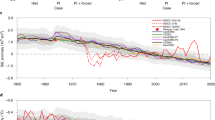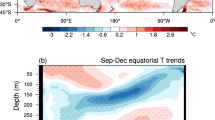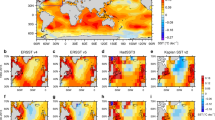Abstract
As exemplified by El Niño, the tropical Pacific Ocean strongly influences regional climates and their variability worldwide1,2,3. It also regulates the rate of global temperature rise in response to rising GHGs4. The tropical Pacific Ocean response to rising GHGs impacts all of the world’s population. State-of-the-art climate models predict that rising GHGs reduce the west-to-east warm-to-cool sea surface temperature gradient across the equatorial Pacific5. In nature, however, the gradient has strengthened in recent decades as GHG concentrations have risen sharply5. This stark discrepancy between models and observations has troubled the climate research community for two decades. Here, by returning to the fundamental dynamics and thermodynamics of the tropical ocean–atmosphere system, and avoiding sources of model bias, we show that a parsimonious formulation of tropical Pacific dynamics yields a response that is consistent with observations and attributable to rising GHGs. We use the same dynamics to show that the erroneous warming in state-of-the-art models is a consequence of the cold bias of their equatorial cold tongues. The failure of state-of-the-art models to capture the correct response introduces critical error into their projections of climate change in the many regions sensitive to tropical Pacific sea surface temperatures.
This is a preview of subscription content, access via your institution
Access options
Access Nature and 54 other Nature Portfolio journals
Get Nature+, our best-value online-access subscription
$29.99 / 30 days
cancel any time
Subscribe to this journal
Receive 12 print issues and online access
$209.00 per year
only $17.42 per issue
Buy this article
- Purchase on Springer Link
- Instant access to full article PDF
Prices may be subject to local taxes which are calculated during checkout





Similar content being viewed by others
Data availability
All data used or analysed in this study, or generated by other groups and organizations, are publicly available at the links provided in the Methods. Data from our model simulations are available at http://kage.ldeo.columbia.edu:81/SOURCES/.LDEO/.ClimateGroup/.PROJECTS/.PublicationsData/.Seager_etal_NCC-2019/.
Code availability
The Python code for the atmosphere model is in a Juypter Notebook and is available on request. The ocean model code is built on legacy Fortran 90 and C code, and a TAR file of the source code can be made available on request.
References
Bjerknes, J. Atmospheric teleconnections from the equatorial Pacific. Mon. Weather Rev. 97, 162–172 (1969).
Dai, A. & Wigley, T. M. L. Global patterns of ENSO-induced precipitation. Geophys. Res. Lett. 27, 1283–1286 (2000).
Trenberth, K. E. et al. Progress during TOGA in understanding and modeling global teleconnections associated with tropical sea surface temperature. J. Geophys. Res. 103, 14291–14324 (1998).
Kosaka, Y. & Xie, S.-P. Recent global-warming hiatus tied to equatorial Pacific surface cooling. Nature 501, 403–407 (2013).
Coats, S. & Karnauskas, K. B. Are simulated and observed twentieth century tropical Pacific sea surface temperature trends significant relative to internal variability? Geophys. Res. Lett. 44, 9928–9937 (2017).
Zebiak, S. E. & Cane, M. A. A model El Niño–Southern Oscillation. Mon. Weather Rev. 115, 2262–2278 (1987).
Delworth, T. L., Zeng, F., Rosati, A., Vecchi, G. A. & Wittenberg, A. A link between the hiatus in global warming and North American drought. J. Clim. 28, 3834–3845 (2015).
Yang, W., Seager, R., Cane, M. A. & Lyon, B. The East African long rains in observations and models. J. Clim. 27, 7186–7202 (2014).
Clement, A. C., Seager, R., Cane, M. A. & Zebiak, S. E. An ocean dynamical thermostat. J. Clim. 9, 2190–2196 (1996).
Cane, M. A. et al. Twentieth century sea surface temperature trends. Science 275, 957–960 (1997).
Knutson, T. R. & Manabe, S. Time-mean response over the tropical pacific to increased CO2 in a coupled ocean–atmosphere model. J. Clim. 8, 2181–2199 (1995).
Vecchi, G. A. & Soden, B. J. Global warming and the weakening of the tropical circulation. J. Clim. 20, 4316–4340 (2007).
Li, G., Xie, S.-P., Du, Y. & Luo, Y. Effects of excessive equatorial cold tongue bias on the projections of tropical Pacific climate change. Part I: the warming pattern in CMIP5 multi-model ensemble. Clim. Dynam. 47, 3817–3831 (2016).
Li, G. & Xie, S. P. Tropical biases in CMIP5 multimodel ensemble: the excessive equatorial Pacific cold tongue and double ITCZ problems. J. Clim. 27, 1765–1780 (2014).
Luo, J.-J., Wang, G. & Dommenget, D. May common model biases reduce CMIP5’s ability to simulate the recent Pacific La Niña-like cooling? Clim. Dynam. 50, 1335–1351 (2018).
Gill, A. E. Some simple solutions for heat-induced tropical circulation. Q. J. R. Meteor. Soc. 106, 447–462 (1980).
Blumenthal., M. B. & Cane, M. A. Accounting for parameter uncertainties in model verification: an illustration with tropical sea surface temperature. J. Phys. Oceanogr. 19, 815–830 (1989).
Uppala, S. M. et al. The ERA-40 re-analysis. Q. J. R. Meteor. Soc. 131, 2961–3012 (2005).
Dee, D. P. et al. The ERA-Interim reanalysis: configuration and performance of the data assimilation system. Q. J. R. Meteor. Soc. 137, 553–597 (2011).
Balmaseda, M. A., Mogensen, K. & Weaver, A. T. Evaluation of the ECMWF ocean reanalysis system ORAS4. Q. J. R. Meteor. Soc. 139, 1132–1161 (2013).
Chiang, J. C. H., Zebiak, S. E. & Cane, M. A. Relative roles of elevated heating and surface temperature gradients in driving anomalous surface winds over tropical oceans. J. Clim. 58, 1371–1394 (2001).
Emile-Geay, J. & Cane, M. A. Pacific decadal variability in the view of linear equatorial wave theory. J. Phys. Oceanogr. 39, 203–219 (2009).
Hu, S. & Federov, A. V. Cross-equatorial winds control El Niño diversity and change. Nat. Clim. Change 8, 798–802 (2018).
Burls, N. J. & Federov, A. V. What controls the mean East–West sea surface temperature gradient in the equatorial Pacific: the role of cloud albedo. J. Clim. 27, 2757–2778 (2014).
Seager, R., Naik, N. & Vecchi, G. A. Thermodynamic and dynamic mechanisms for large-scale changes in the hydrological cycle response to global warming. J. Clim. 23, 4651–4668 (2010).
Wu, Y. & Polvani, L. M. P. Contrasting short- and long-term projections of the hydrological cycle in the southern extratropics. J. Clim. 28, 5845–5856 (2015).
Davey, M. K. & Gill, A. E. Experiments on tropical circulation with a simple moist model. Q. J. R. Meteor. Soc. 113, 1237–1269 (1987).
Zebiak, S. E. Atmospheric convergence feedback in a simple model for El Niño. Mon. Weather Rev. 114, 1263–1271 (1986).
Seager, R. A simple model of the climatology and variability of the low-level wind field in the tropics. J. Clim. 4, 164–179 (1991).
Seager, R., Zebiak, S. E. & Cane, M. B. A model of the tropical Pacific sea surface temperature climatology. J. Geophys. Res. 93, 1265–1280 (1988).
Israeli, M., Naik, N. A. & Cane, M. A. An unconditionally stable scheme for the shallow water equations. Mon. Weather Rev. 128, 810–823 (2000).
Ishii, M. & Kimoto, M. Reevaluation of historical ocean heat content variations with time-varying XBT and MBT depth bias corrections. J. Oceanogr. 65, 287–299 (2009).
Carton, J. A. & Giese, B. S. A reanalysis of ocean climate using Simple Ocean Data Assimilation (SODA). Mon. Weather Rev. 136, 2999–3017 (2008).
Good, S. A., Martin, M. J. & Rayner, N. A. EN4: quality controlled ocean temperature and salinity profiles and monthly objective analyses with uncertainty estimates. J. Geophys. Res. Oceans 118, 6704–6716 (2013).
Kobayashi, S. et al. The JRA-55 reanalysis: general specifications and basic characteristics. J. Meteor. Soc. Jpn 93, 5–48 (2015).
Compo, G. P. et al. The twentieth century reanalysis project. Q. J. R. Meteor. Soc. 137, 1–28 (2010).
Taylor, K. E., Stouffer, R. J. & Meehl, G. A. An overview of CMIP5 and the experimental design. Bull. Am. Meteor. Soc. 93, 485–498 (2012).
Kay, J. E. et al. The Community Earth System Model (CESM) Large Ensemble Project: a community resource for studying climate change in the presence of internal climate variability. Bull. Am. Meteor. Soc. 96, 1333–1349 (2015).
Rayner, N. A. et al. Global analyses of sea surface temperature, sea ice, and night marine air temperature since the late nineteenth century. J. Geophys. Res. 108, 4407 (2003).
Kistler, R. et al. The NCEP–NCAR 50-year reanalysis: monthly means CD-ROM and documentation. Bull. Am. Meteor. Soc. 82, 247–268 (2001).
Huang, B. et al. Extended Reconstructed Sea Surface Temperature, version 4 (ERSSTv5): upgrades, validations and intercomparisons. J. Clim. 30, 8179–8205 (2017).
Acknowledgements
This work was supported by NSF award OCE 1657209 and a grant from World Surf League P.U.R.E. through Columbia University’s Center for Climate and Life. We thank R. Miller, B. Fox-Kemper, T. Shepherd, R. Chadwick, J. Smerdon, P. Williams and I. Simpson for useful discussions.
Author information
Authors and Affiliations
Contributions
R.S. conceived of the study and directed the research. All authors designed the experiments. R.S. and M.C. designed the atmosphere and ocean thermodynamic models. N.H. and M.C. designed the numerical methods for solution, with assistance from R.S. N.H. wrote the new model codes, implemented the ocean model and conducted the modelling. D.-E.L. and N.H. led the analysis of ocean and atmosphere data. D.-E.L. conducted experiments with the ocean model to interpret the results. R.S. wrote the paper, with all authors contributing advice on content and wording.
Corresponding author
Ethics declarations
Competing interests
The authors declare no competing interests.
Additional information
Peer review information: Nature Climate Change thanks Natalie Burl and the other, anonymous, reviewer(s) for their contribution to the peer review of this work.
Publisher’s note: Springer Nature remains neutral with regard to jurisdictional claims in published maps and institutional affiliations.
Rights and permissions
About this article
Cite this article
Seager, R., Cane, M., Henderson, N. et al. Strengthening tropical Pacific zonal sea surface temperature gradient consistent with rising greenhouse gases. Nat. Clim. Chang. 9, 517–522 (2019). https://doi.org/10.1038/s41558-019-0505-x
Received:
Accepted:
Published:
Issue Date:
DOI: https://doi.org/10.1038/s41558-019-0505-x
This article is cited by
-
Improving our understanding of future tropical cyclone intensities in the Caribbean using a high-resolution regional climate model
Scientific Reports (2024)
-
Historical changes in wind-driven ocean circulation drive pattern of Pacific warming
Nature Communications (2024)
-
Drivers of Caribbean precipitation change due to global warming: analyses and emergent constraint of CMIP6 simulations
Climate Dynamics (2024)
-
Enhanced influence of tropical Atlantic Sea surface temperature anomalies on east Asian summer monsoon since the late 1970s
Climate Dynamics (2024)
-
Revisiting the equatorial Pacific sea surface temperature response to global warming
Climate Dynamics (2024)



